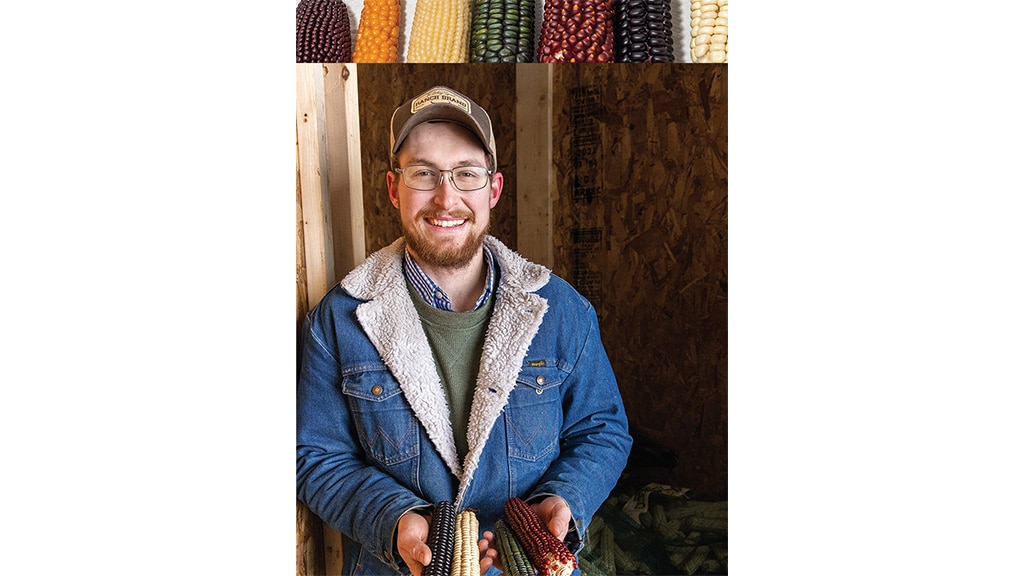
Jordan Roberge became curious about growing heirloom corn varieties in 2000 and decided to keep growing them for their beauty, flavor profile, and marketing potential. He now grows a mix of popcorn, dent corn, flour corn, and flint corn.
Agriculture, Specialty/Niche June 01, 2024
Taste of History
Quebec grower says heirloom varieties' flavor can't be matched.
by Lorne McClinton
Jordan Roberge is fascinated by everything to do with corn. He loves growing it, processing it, and researching new value-added ways to market it. But his eyes start dancing with excitement when he talks about his work with heirloom corn.
Grey-bearded farmers have experience and wisdom, but few can match the passion and fervor that young farmers like Roberge bring to the table. His excitement and his willingness to explore ideas off the beaten path are a breath of fresh air.
"I think about corn all the time," Roberge says. "I wake up and think about corn all day; and sometimes even dream about it."
Roberge started growing heirloom corn varieties on his vegetable farm near Saint-Isidore, Quebec, out of curiosity in 2000. He decided to keep growing them for their beauty, flavor profile, and marketing potential.
"I thought that I can do more for Quebec agriculture," says Roberge. "Breeding programs are all about yield, but I think the nutritional value of corn has decreased over time. It's become a mission of mine to give people the chance to try the older varieties. Preserving biodiversity for the future is also part of it."
Initially Roberge started to look for heirloom varieties that were grown in Quebec. The only one of interest to him was an old, white Iroquois variety that had a unique flavor profile and produced decent yields. When he didn't find any others that appealed to him, he expanded his search area into the United States.
"Americans have a lot of heirloom corn, and in time I found a couple varieties that met my needs," Roberge says. "I'm looking for tasty, nutritious grain that will still produce a good yield. Here in Beauce heirloom corn varieties only have one third the yield that hybrid corn has."
Each variety Roberge selected has its own purpose. The white Iroquois variety produces a marvelous corn meal; he grows a red-kernel flint corn for its beauty which makes it stand out in fall displays. One, a purple variety, is loaded with antioxidants, like those found in super foods like blueberries and raspberries. He's selected a green variety for its taste after friends started raving about it in informal taste tests. Some of Roberge's favorites are popcorn varieties.
"I grow a strawberry popcorn that once popped is approximately the size of my little finger," Roberge says. "It's very small, but very beautiful and it tastes great. I'm also going to keep one I found in Pennsylvania that tastes like it's already been buttered."
Over the past three years, Roberge has focused on understanding the potential, taste, climate adaptability, and tested potential markets for different heirloom varieties. He kept test plots small enough that he could harvest his cobs by hand for this stage. Now he's confident in his varieties and is ready to take it to the next level. In 2024 he's reducing the number of varieties he's growing and is planning to expand his acreage.
Response to flours made from his heirloom corn varieties has been overwhelmingly positive. This fall he plans to sell whole cobs, flour, popcorn, and ornamental corn stalks at both his farm store and in area farmers' markets. Other friends have requested product to sell at their stores and farmers' markets in the area and further afield, too. He's also working with an artisanal bakery that hopes to produce a line of baked goods from his flours in the future. ‡
Read More

AGRICULTURE, SUSTAINABILITY
Spotlight on Sulfur
The missing ingredient in many row crop nutrient plans.

